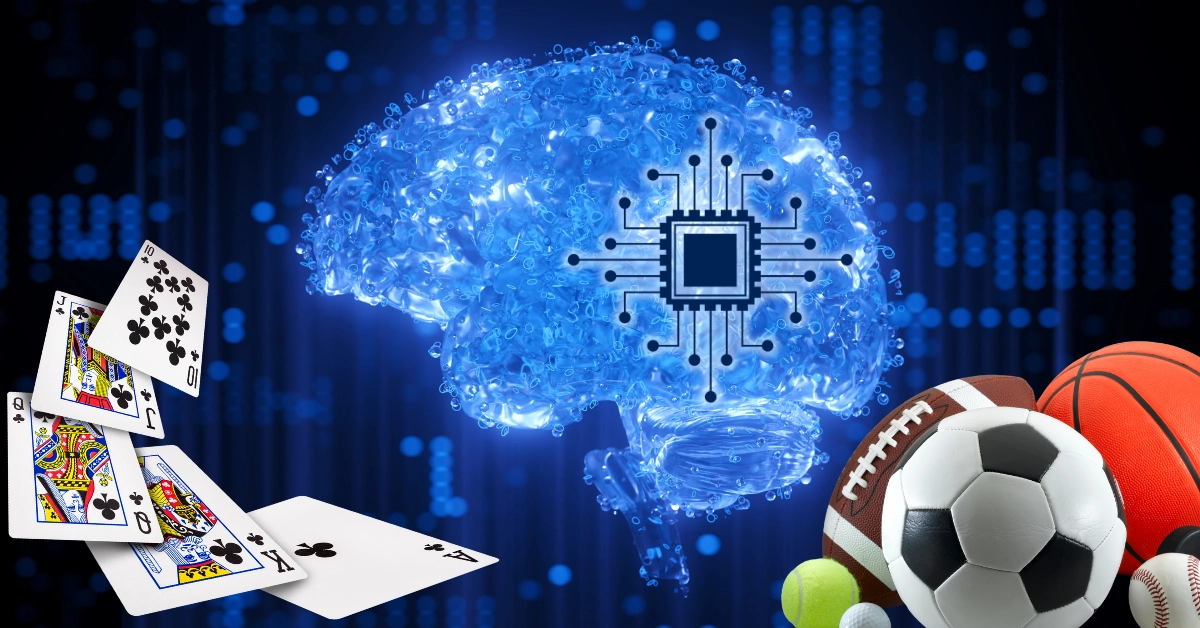Neural Implants for Real-Time Betting: Sci-Fi or a Future Reality?

We’ve reached a point in tech that is equal parts fascinating and scary—neural implants. Why are we even bringing it up? Because in the not-too-distant future, you could be able to bet on the Super Bowl or a presidential election with your thoughts.
That’s right, you won’t need a computer or a smartphone—just your brain waves. If it sounds like we are describing a movie like Upgrade or The Matrix, you’re not too far off; but it’s not something that was ripped from a cyberpunk novel and neural implants are closing in on reality. The devices, which are made to be a conduit between biology and technology, could someday change how we interact with everything—and that includes gambling.
The question isn’t whether this tech could exist, but should it? Advancements in neuroscience, AI, and real-time data processing are making thought-controlled betting more and more plausible, but the thought of embedding chips in our brains? Um, that’s kinda terrifying if you ask us. We’re talking about merging human cognition with algorithms that predict odds, analyze risks, and will financially profit from our impulses.
And our skepticism is warranted, as companies like Neuralink have already demonstrated that brain-computer interfaces (BCIs) enable monkeys to play video games using their minds. Pair that with AI-driven gambling sites and 5G’s instant connectivity, and the line between sci-fi and reality has disappeared. So, before we hand over our gray matter to Silicon Valley, we need to ask: Are we ready to literally gamble with our brains? And if we are, should we?
Understanding Neural Implants
Okay, so neural implants, which were once the stuff of dystopian fiction, are now very real, albeit still very experimental, devices. Basically, the implants are brain-computer interfaces (BCIs): tiny electrodes or chips that interact with neural signals, translating the brain’s electrical activity into digital commands. It’s kinda like a Bluetooth but for your brain, and instead of connecting to headphones, it links directly to software, apps, or other people’s devices.
The Pioneers in Brain-Computer Interfaces
Yes, the concept sounds futuristic, but companies like Neuralink, which was founded by Elon Musk, are already testing out prototypes. Their implant, which is about the size of a coin, aims to help paralyzed individuals control external devices with their minds. In 2021, Neuralink showcased a monkey playing the video game Pong using only its thoughts. The innovators, like Synchron and Blackrock Neurotech, are developing less invasive alternatives—like BCIs that sit in blood vessels or on the brain’s surface—to avoid risky open-skull surgical procedures (yeah, no thanks).
Real-Time Data: From Brain to Bet
The critical factor that’s enabling thought-driven applications? Speed. Modern BCIs can process neural signals in milliseconds, and 5G networks and AI-powered algorithms handle data transmission and analysis pretty much instantaneously. This opens the door to scenarios where a passing thought—say, “Bet $250 on black”—could trigger a real wager before you consciously make the decision.
It’s this very speed that raises some thorny questions. If neural implants can act on impulses faster than our own self-awareness, who—or what—is really in control?
The Intersection of Neural Implants and Betting
A marriage between neural implants and gambling all hinges on one simple word: immediacy. By bypassing the physical devices and manual inputs, the interfaces would enable bets to be placed at the speed of thought. That sounds cool and convenient, but is it? It’s a huge change in how human beings interact with risk, chance, and the algorithms that profit from both aspects.
Neural implants could eliminate the friction between intention and action. A user watching a horse race, for instance, might instinctively “think” a bet as the final stretch unfolds. The implant detects their neural signals, interprets the intent, and executes the wager via a linked betting platform—all before the race ends. It takes away any kind of delay that comes from typing, tapping, or voice commands.
In fast-paced betting markets—like in-play sports or live casino games—milliseconds really matter. Neural signals travel faster than fingers can swipe, which would give the users who have implants an edge over the bettors who don’t. And for high-stakes gamblers, this could mean capitalizing on odds shifts or last-minute game developments before others have the chance to react.
Pairing neural data with AI-driven betting platforms raises the stakes even further. How? Because implants would be able to feed real-time biometric data—like adrenaline spikes or subconscious risk assessments—into algorithms that change odds or recommend bets. There could be a system that knows you’re feeling confident during a poker hand and nudges you to raise, and it’s all based on your brain.
But hold up! A seamless integration like this comes with a ton of risks. If a device can act on our subconscious impulses or preconscious thoughts, where does smart decision-making end and automated exploitation begin? The allure of speed will most likely come at the cost of our autonomy—it’ll turn our noggins into unwitting collaborators with the house, and the house always wins.
Technological Feasibility: How Close Are We Really?
The whole idea of thought-driven betting relies on three pillars: hardware capable of reading brain activity, software that deciphers it accurately, and an infrastructure that is fast enough to act on it. And although progress is accelerating, each pillar is up against its own hurdles—and not all in them are purely technical.
The Current State of Neural Implants
Companies like Neuralink, Synchron, and Blackrock Neurotech are dominating the BCI landscape, but all of their goals are different. Neuralink’s fully implantable device targets medical applications like restoring mobility, and Synchron’s stent-like “Stentrode” focuses on enabling paralyzed patients to control digital devices via blood vessels. Blackrock’s Utah Array, a microelectrode grid, has been used in research for decades. All of these devices can interpret basic motor commands (e.g., moving a cursor), but translating abstract thoughts—like betting intent—is still uncharted territory.
The Hurdles of Real-Time Processing
Even the most advanced BCIs struggle with two bottlenecks: specificity and latency. Neural signals are noisy, and isolating the exact intent to “place a bet” from the brain’s background activity is like trying to identify one voice in a packed stadium. Current systems also operate with slight delays, which could be catastrophic in fast-moving betting scenarios. A lag of 500 milliseconds? That could mean missing the window to bet on a goal in soccer.
Breakthroughs
Recent advances do suggest that some solutions are coming to the fray, like machine learning models, which are trained on vast neural datasets. They are getting much better at predicting intent from sparse signals. In 2023, researchers at Stanford used AI to decode attempted handwriting motions from paralyzed patients with 94% accuracy. Companies like Paradromics are developing high-bandwidth implants that process data 100x faster than any earlier models. Wireless BCIs, like those from Precision Neuroscience, want to decrease surgical risks, which in turn make consumer applications more viable.
Still, these are very early days. While the tech is baby-stepping toward plausibility, the leap from medical tools to seamless, consumer-ready betting interfaces all hinges on solving the ethical dilemmas as much as engineering ones. Because decoding, “I really want a cheesesteak” is one thing. Interpreting “I’ll risk $1,000 on this blackjack hand?” That’s another thing entirely.
Ethical and Regulatory Concerns
The thing with neural implants in betting isn’t only a technical challenge—it’s an ethical nightmare. From privacy breaches to the erosion of personal agency, the stakes extend way beyond financial loss. Next up, we take a look at what probably keeps ethicists, regulators, and some developers up at night.
Privacy: Who Owns Your Thoughts?
Neural implants generate a constant stream of data, including our subconscious impulses and emotional states. If gambling sites have access to this kind of info, they could exploit vulnerabilities in real time—say, targeting users when they’re emotionally vulnerable or tired. And the scariest thing? Hacked neural data could expose intimate details, like risk tolerance or decision-making patterns, to malicious actors. The question isn’t just about data security but if anyone should have access to the raw feed of a human mind.

Addiction on Autopilot
The ease at which we can bet already fuels addictive behaviors, and with neural interfaces, placing a wager would be as effortless as blinking. The lack of any physical friction—no wallet, no app, no confirmation screen—could take away the last barriers to impulsive gambling. Platforms might even be able to leverage the neural data to identify and exploit addictive tendencies and then tailor odds or incentives that are based on a user’s brain activity. Responsible gambling tools, like spending limits, would need to evolve in radical ways to keep up.
Regulation: Playing Catch-Up
Current gambling laws just aren’t equipped to handle thought-driven wagers, and they may never be. How do you actually prove consent when a bet is placed via neural signal? Can algorithms be audited to guarantee that they don’t manipulate users’ decisions? Regulatory frameworks would need to mandate transparency in how neural data is used, enforce strict consent protocols, and penalize any predatory practices. Some experts are arguing for “neuro-rights” legislation, which would treat neural data as a protected category akin to how HIPAA does with medical records.
The way forward will take so much more than innovation—it will take solid guardrails. Without the strongest ethical standards and oversight, neural betting could turn brains into profit-driven algorithms that will outmaneuver our human judgment.
Potential Benefits and Risks for the Gambling Industry
Neural implants could absolutely propel the gambling industry into a new era of innovation—or plunge it into uncharted chaos. For operators, there’s the pull of faster transactions, better user engagement, and untapped markets; that’s just an undeniable fact. But lurking beneath the opportunities are hazards that could erode consumer trust, bring regulatory crackdowns, and expose vulnerabilities that are ripe for exploitation. The industry’s ability to walk this tightrope if and when it comes to fruition—like harnessing the tech’s possibilities without succumbing to its darker implications–will have a huge role in its future relevance. The following are the very real benefits and the very real risks that come with this territory!
Benefits
For gambling platforms, neural interfaces would be a chance to redefine user engagement and revenue streams totally.
| Benefit | Details |
|---|---|
Frictionless Interaction | Eliminating the need for screens or physical inputs could super-streamline betting, and that would attract tech-savvy users who want speed and convenience. A seamless experience could also convert casual bettors into frequent users. |
Hyper-Personalization | Neural data could let platforms tailor odds, rewards, and marketing in real time. For example, detecting a user’s excitement during a basketball game could trigger targeted live-betting offers, which would boost engagement. |
Market Expansion | Thought-driven betting could open up entirely new demographics, like people who have physical disabilities and struggle with traditional interfaces, which would broaden the industry’s reach. |
Risks
The very same features that make neural betting so lucrative? Well, they also expose the industry to unprecedented dangers and we aren’t being dramatic.
| Risk | Details |
|---|---|
Security Nightmares | Neural implants create a heavenly scenario for hackers. A breach could expose sensitive neural data—like subconscious biases or emotional triggers—to manipulation or even blackmail. |
Systemic Exploitation | Malicious actors might hijack implants to make unauthorized bets or skew outcomes. Insider threats, like rogue employees altering algorithms, could undermine trust in betting platforms. |
Regulatory Blowback | Public backlash over privacy violations or addiction risks would very likely trigger harsh regulations, which would stifle innovation or shrink profit margins. |
The Survival of Traditional Platforms
If this comes to fore, the legacy betting companies will face existential pressure to adapt. Some could possibly partner up with BCI developers to stay relevant, and the ones that don’t? They risk becoming obsolete. Not to mention the smaller operators who would be unable to afford neural tech—they could lose market share to tech giants like Meta or Apple, and that would ramp up the industry’s consolidation.
The gamble here isn’t only a financial one—it’s also whether an industry that is built upon risk can responsibly navigate a future where our brains turn into the floor of a casino.
Is This the Future of Betting or Just Sci-Fi?
The concept of neural implants for gambling sits at the crossroads of ambition and reality. On paper, the pieces are falling into place: brain-computer interfaces (BCIs) are advancing, AI gets more sophisticated by the day, and the gambling industry is always hungry for innovation. But how much of this vision is grounded in today’s science, and how much is speculative fiction? Below, we separate the hype from actual possibility.
Current Tech vs. The Vision
Today’s BCIs excel at decoding basic motor commands—like moving a cursor or a robotic arm—but they struggle with abstract intentions. Neuralink’s primate experiments or Synchron’s stroke-patient trials focus on restoring lost functions, not facilitating complex decisions like with betting. The jump from “move left” to “bet $250 on Team A” all depends on interpreting nuanced cognitive patterns, a challenge neuroscientists are still grappling with. For betting-specific implants to work, devices would need to distinguish impulsive thoughts from deliberate intent, and that’s a frontier that even the best labs haven’t breached.
Expert Predictions: Optimism vs. Skepticism
- Proponents like John Donoghue, a pioneer in neurotechnology, argue that BCIs could evolve beyond medical use within 20–30 years. Startups like Neurable already market non-invasive headsets for basic brain-controlled gaming, which hints at a path toward consumer adoption.
- Critics, however, highlight ethical and technical roadblocks. Dr. Anna Wexler, a bioethicist at UPenn, warns: “Translating ‘I want to bet’ into a reliable neural signal isn’t just a coding problem—it’s a philosophical one. Where does the brain end and the algorithm begin?”
Research Accelerating the Timeline
Big breakthroughs suggest that the progress isn’t stagnant. Projects like the BrainGate Consortium have demonstrated rapid decoding of handwriting intent from neural signals. Meanwhile, AI models like OpenAI’s GPT-4 show an eerie proficiency in predicting human behavior, which could pair with neural data to anticipate betting choices. DARPA’s Next-Generation Nonsurgical Neurotechnology (N3) program has the goal of developing non-invasive, high-resolution BCIs, and that would be a super important step for mass adoption.
So, is neural betting inevitable? Nope, not yet! But there are billions of dollars that are flowing into neurotech and AI, and that means that the gap between sci-fi and reality is narrowing. Once again, the question isn’t “Can we?” but “Should we?”—and whether or not society will accept a world where the casino literally lives in our heads.
What It Means for Gamblers: Practical Implications
Neural implants could radically alter not just how bets are placed but how gamblers interact with risk itself. From split-second decisions in live sports to AI-guided poker strategies, the very nature of gambling—as a combo of luck, skill, and psychology—could be rewritten. The following is how everyday bettors would experience this shift!
Redefining Sports Betting, Casinos, and Financial Wagering
- Sports Betting: Reacting to a fumbled football catch as it happens, placing a live bet through a neural impulse before the play even ends. Delays caused by app load times or distracted scrolling vanish, turning spectators into hyper-responsive participants.
- Casino Games: In poker, neural interfaces could enable real-time “tells” detection, analyzing opponents’ subconscious micro-impulses (e.g., hesitation before a bluff) through linked implants. Blackjack players might receive instant probability calculations via augmented reality overlays, fed directly into their visual cortex.
- Financial Wagering: Betting on cryptocurrency fluctuations, commodity prices, or economic indices could happen reflexively. A gambler tracking Bitcoin’s volatility, for instance, might place a spread bet the moment their brain registers a trend shift—no screens or manual inputs required.
Skill-Based Gambling: Sped Up
Neural implants could turn gambling into a contest of neural agility. Games like esports betting or live trivia, where milliseconds determine outcomes, might favor users with faster brain-to-device latency. Over time, a “neuro-advantage” divide could emerge, similar to how high-frequency trading dominates stock markets. Competitions might even require participants to use standardized implants to level the playing field—turning gambling into a cyborg sport.
Real-Time Feedback
Implants could offer gamblers something unprecedented: a live dashboard of their cognitive biases. Think of it as a Fitbit for betting habits. Sensors might alert users when stress hormones spike during a losing streak, nudging them to pause. AI coaches could analyze neural patterns to flag impulsive bets or recommend strategies based on past successes.
But this raises a paradox: If algorithms optimize every decision, does gambling lose its soul—the thrill of uncertainty?
Neural tech does hold the promise of control but threatens autonomy for players. The line between skilled play and algorithmic dependency will blur, and that leaves us (and gamblers) to wonder if they are still betting, or is the bet placing itself?
Conclusion: Cashing in on Your Cortex
If the idea of betting with your mind sounds like a good idea, we totally get it! Just think it, and it’s a done deal. And although we agree that it’s an interesting idea, it’s also creepy to realize that it could be done. But it’s gonna be a hard “no” on the open brain surgery for us.
Let’s do a quick recap on the possible impact that neural implants could have on real-time betting:
- The Good: Instantaneous bets, hyper-personalized odds, and a sci-fi edge that could make you feel like you’re Neo in The Matrix.
- The Bad: Your brain data becomes the hottest commodity since Bitcoin, and addiction rates shoot up faster than a SpaceX rocket.
- The Ugly: Hackers, rogue algorithms, and the existential dread of wondering if that “gut feeling” was ever really yours in the first place.
Right now, neural betting is straddling the fence somewhere between “Cool story, bro” and “OMG, it’s happening.” Tech giants are racing toward BCIs, AI is getting scarily intuitive, and the gambling industry loves a shiny new toy. While we’re not quite at Black Mirror levels (yet), shrugging this off as a pure fantasy feels a little bit naïve—like when we all assumed that social media would never sell our data.
Here’s our advice: Be curious, stay really skeptical, and maybe keep your wallet (and your skull) on lockdown. Because if history has taught us anything, it’s that humanity will bet on absolutely anything—even its own obsolescence.
FAQs
Our neurons are on high alert after all of that, and we know that yours probably have some more questions—maybe even an ookie sense of existential dread. Look below for the FAQs that our readers have asked about neural implants!
What Are Neural Implants, and How Do They Work?
Okay, so just think of them as weird little brain buddies that eavesdrop on all of your neurons. The devices (BCIs) intercept the electrical signals in your skull and translate them into commands for computers. And no, you can’t pair them with AirPods…yet.
Could Neural Implants Really Be Used for Betting?
In theory, sure! But that’s only if you’re cool with letting Silicon Valley monetize your neurons. Today’s BCIs help paralyzed people type. Tomorrow’s? Maybe they’ll let you bet your life savings on a hockey game while you type.
How Close Is This Technology to Becoming a Reality?
It’s closer than your last bad beat at poker, but it’s light-years from mainstream use. Neuralink’s monkey can play “Pong.” Your grandkids might get to bet on “Pong” by only using their thoughts.
Are There Risks Associated with Using Neural Implants for Gambling?
Only if you consider brain hacking, addiction turbochargers, and corporations owning your impulses to be “risks.” Seriously, algorithms would be able to turn your emotional crisis into a revenue stream. Don’t say we didn’t warn you!
How Might Neural Implants Change the Gambling Industry?
It would be like Las Vegas, but in your head. Faster bets! Personalized losses! And if and when it finally happens? Regulators will be too busy Googling “What’s is a neuron?” to stop it.

Alyssa contributes sportsbook/online casino reviews, but she also stays on top of any industry news, precisely that of the sports betting market. She’s been an avid sports bettor for many years and has experienced success in growing her bankroll by striking when the iron was hot. In particular, she loves betting on football and basketball at the professional and college levels.








